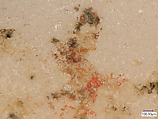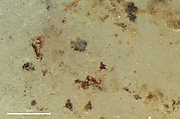On loan to The Met The Met accepts temporary loans of art both for short-term exhibitions and for long-term display in its galleries.
Marble female figure
Technical analysis: Multiband imaging, optical microscopy, Raman spectroscopy
The figure is carved from an extremely fine-grained white marble (maximum grain size < 0.5 mm). It is intact and remarkably well preserved. Red-orange accretions adhere to parts of the figure, especially on the proper left side. There are traces of red pigment identified as cinnabar on the front of the neck and chest as well as the proper right foot although no pattern is discernable.
The angular, featureless head tilts back slightly and sits on a long neck. The neck widens at the shoulders which extend to stubs signifying the arms. The torso is flat while the legs are worked in the round with curving thighs which extend from wide hips that frame a large triangular pubis cleft in the middle. The figure stands on its feet arch slightly and are plastically modelled.
The figure is a characteristic example of the Louros type, which is named after an Early Cycladic necropolis on Naxos where figures of this type have been found. The hybrid form combines the essentially schematic features of the upper body evident in earlier violin type figures with the more sculptural naturalistic rendering of the contemporary Plastiras type as seen in the figure’s legs and feet. The closest typological parallel is a figure in the National Archaeological Museum in Athens (NAM 6140.11), which was one of seven Louros type figures found in Grave 26 at Louros on Naxos.
Seán Hemingway, Dorothy Abramitis, Federico Carò
This image cannot be enlarged, viewed at full screen, or downloaded.
This artwork is meant to be viewed from right to left. Scroll left to view more.











